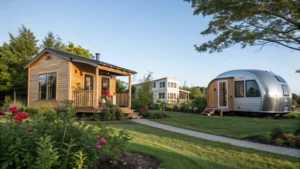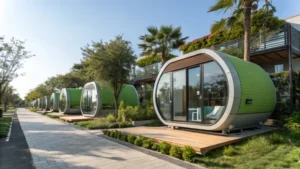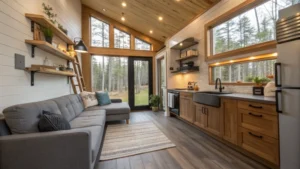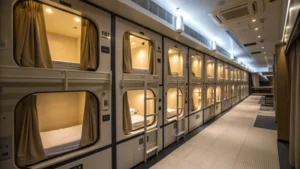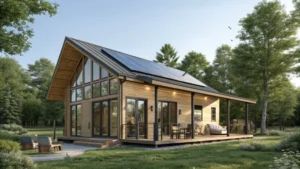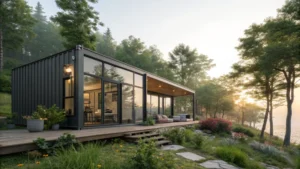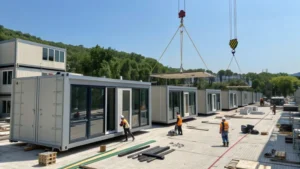
Ever wondered how China’s turning tiny spaces into futuristic, cozy homes?
China builds ultra-modern capsule houses using modular construction techniques, high-tech materials like carbon fiber, and smart technologies such as solar panels and IoT systems. These innovations ensure rapid, cost-effective, and sustainable housing solutions.
When I first stumbled upon the idea of capsule houses, it was like discovering a hidden gem in the world of architecture. Beyond the efficiency of modular construction, these homes are crafted with an attention to detail that resonates with anyone who values sustainability and style. Imagine walking into a space that feels tailored just for you, with energy-efficient features that make both environmental and economic sense. These homes aren't just about fitting into smaller footprints—they're about expanding possibilities for living, especially in areas where traditional building methods fall short.
China uses carbon fiber in capsule house construction.True
Carbon fiber is used for its strength and lightweight properties.
Chinese capsule houses lack energy-efficient features.False
They include solar panels and IoT systems for efficiency.
How Does Modular Construction Transform Capsule House Building?
Imagine being able to assemble a home as quickly as building a set of LEGO bricks, with each piece fitting perfectly into the next. That's the magic of modular construction in capsule houses.
Modular construction revolutionizes the creation of capsule houses by offering rapid assembly, cost savings, and consistent quality. Prefabricated modules are crafted off-site, ensuring uniformity and allowing for swift on-site assembly, ideal for urban settings.
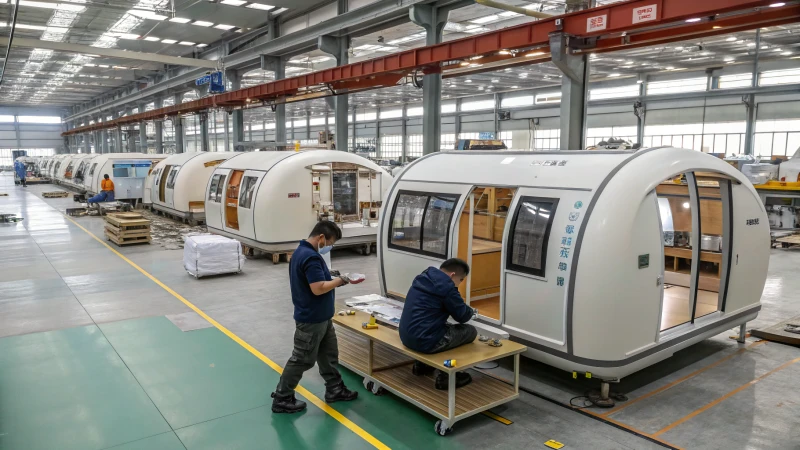
Modular Construction: A Game Changer
Let me take you on a little journey into the world of modular construction—a world where homes are built not piece by piece on-site but in a factory, like a car assembly line. I remember visiting a factory in China where these modules were being pieced together with such precision, it felt like watching a symphony being orchestrated. These modules, crafted in controlled environments, are then transported to their final destination, where they are rapidly assembled into a complete structure. This method not only slashes construction time but also ensures each module meets the highest standards before being shipped.
A key advantage is the control over quality and materials1 in a factory environment. With consistent conditions, manufacturers can ensure each module meets high standards before it's shipped to the site.
Benefits in Building Capsule Houses
Speed and Efficiency
Time is of the essence, especially when you're racing against weather delays or pressing deadlines. I recall a project where we needed to have capsule houses ready for an eco-resort opening in just weeks—modular construction was our savior! Unlike traditional methods that could stretch over months, our team completed the assembly in about 8 weeks, thanks to the modules being pre-built in factories.
| Feature | Traditional Construction | Modular Construction |
|---|---|---|
| Construction Time | 6–12 months | 6–12 weeks |
| Cost Control | Variable | Fixed |
| Quality Assurance | Inconsistent | Consistent |
Sustainability
What’s even more exciting is how sustainable this method is. It's like having your cake and eating it too! Less waste, more efficiency. I’ve seen materials reused seamlessly across projects, making it not just eco-friendly but also cost-effective. Capsule houses often come equipped with features like solar panels and rainwater systems—technology that makes Mother Nature smile.
Customization and Flexibility
Customization is at the heart of modular construction. I’ve had clients who wanted their capsule houses to mirror luxury yachts or cozy mountain cabins. This flexibility is a boon for niche markets, allowing for unique designs that cater to specific client tastes and needs.
For example, manufacturers in China offer custom designs2 tailored to specific industries, allowing developers to create unique and appealing spaces that stand out in competitive markets.
Challenges and Considerations
Of course, no system is without its challenges. Navigating local building codes can sometimes feel like solving a complex puzzle, and transporting these large modules to remote locations isn't always straightforward. Yet, with every challenge comes innovation—and I’m continually amazed at how technology advances to tackle these hurdles.
In summary, modular construction is reshaping how we think about housing. It’s more than just a building method; it’s a movement towards a sustainable, efficient future.
Modular construction reduces on-site building time by 80%.True
Modular construction significantly cuts down on-site time from months to weeks.
Capsule houses built modularly have inconsistent quality.False
Factory conditions ensure consistent quality in modular construction.
How Do Advanced Materials Enhance the Efficiency of Capsule Homes?
Imagine living in a space that feels as cutting-edge as the technology that powers it. Capsule homes, with their sleek design and advanced materials, are transforming the way we think about sustainable living.
Advanced materials like carbon fiber and eco-friendly composites enhance capsule home efficiency by reducing weight, boosting insulation, and integrating smart technologies, all of which contribute to sustainability and lower energy costs.

The Role of Lightweight Materials
I've always been fascinated by how something as simple as a change in material can transform an entire structure. Take carbon fiber and insulated steel, for example. These materials have become game-changers in capsule home construction. I remember reading about how they can slash the weight of a building by nearly 40%. This weight reduction isn't just a number on a scale—it makes transporting and setting up these homes a breeze, especially in hard-to-reach places.
Carbon Fiber Advantages
- Weight Reduction: Up to 40% lighter than traditional materials.
- Increased Strength: Provides enhanced durability to withstand environmental stresses.
- Portability: Easier to transport, cutting down logistical hurdles.
Integration of Smart Technology
The marriage of advanced materials with smart technology is like something out of a sci-fi movie. Picture this: solar panels seamlessly integrated into your roof, or an IoT system that lets you control your home’s functions from anywhere. I’ve been in homes where the temperature control was so efficient, it felt like the house knew what I needed before I did. This isn't just about convenience; it's about creating a truly sustainable lifestyle within a compact space.
- Solar Panels: Built into roofs to reduce reliance on external power sources.
- IoT Systems: Facilitate remote monitoring and management of home functions.
- Temperature Control: Efficient insulation lowers heating and cooling costs.
Eco-Friendly Composites
Using eco-friendly composites in capsule homes is like giving Mother Nature a high-five while making your home look incredible. I once stayed in a capsule home that used recycled steel and biodegradable insulation, and it was amazing to see how these materials not only reduced the carbon footprint but also improved thermal efficiency.
| Material | Benefits |
|---|---|
| Recycled Steel | Lowers carbon footprint; highly durable |
| Biodegradable Insulation | Enhances thermal efficiency; sustainable |
Incorporating these advanced materials into capsule homes not only boosts their sustainability3 but also makes them attractive options in eco-tourism and luxury markets. Imagine customizing these homes with bespoke designs while maintaining high standards of eco-friendliness and efficiency.
Customization for Niche Markets
When it comes to niche markets like luxury tourism or disaster relief, the ability to customize is crucial. I’ve seen designs tailored so perfectly for specific needs that they become part of the landscape—luxury finishes for upscale aesthetics or structural features designed to withstand harsh environments.
- Luxury Finishes: High-end materials elevate the look and feel of a space.
- Structural Features: Custom designs meet varied environmental conditions.
By embracing these innovative materials and technologies, capsule homes offer modern solutions to housing challenges, particularly in areas where traditional construction might falter. The use of advanced materials not only boosts efficiency but also aligns with the global push towards sustainable living solutions4.
Carbon fiber reduces capsule home weight by 40%.True
Carbon fiber significantly reduces weight, enhancing transport and installation efficiency.
Eco-friendly composites increase capsule home energy costs.False
Eco-friendly composites lower energy costs by improving insulation and sustainability.
What Smart Technologies Are Integrated into Capsule Houses?
Have you ever dreamt of living in a space that's straight out of a sci-fi movie, yet cozy and sustainable?
Capsule houses integrate smart technologies such as IoT systems for automation, solar panels for energy efficiency, and advanced materials for sustainability. These features not only enhance functionality but also reduce environmental impact, making capsule houses perfect for modern living.

IoT Systems and Home Automation
I remember the first time I stepped into a capsule house—it was like walking into the future. The lights adjusted themselves as if they knew exactly how much brightness I needed. With IoT systems, controlling lighting, security, and appliances becomes as easy as tapping on your smartphone. Imagine being able to turn off the lights you forgot about while already tucked in bed or adjusting your home's temperature from miles away. It's all about efficiency5 and convenience, making everyday life just a bit more magical.
| Smart Technology | Functionality | Benefit |
|---|---|---|
| IoT Systems | Remote control | Efficiency |
| Smart Thermostats | Temperature control | Energy savings |
Solar Panels and Energy Efficiency
One of my favorite aspects of capsule houses is their commitment to sustainability. Picture this: reducing your electricity bills while basking in the warmth of knowing you're doing your bit for Mother Earth. With solar panels installed, these homes significantly cut down on traditional energy reliance. This technology not only cuts down on energy costs6 but also minimizes environmental footprints. Some designs integrate battery storage solutions to harness solar power effectively.
Advanced Materials and Sustainability
The materials used in building these capsule homes are just as impressive. Using carbon fiber and insulated steel means these houses are light yet incredibly durable. These materials reduce weight7 and enhance portability. I once imagined my ideal home to be both eco-friendly and long-lasting—capsule houses make that dream come true with their innovative use of materials that protect the environment without compromising on strength.
Smart Temperature Control Systems
And then there’s the smart thermostats—my personal favorite! They learn your preferences over time and adjust the temperature to your liking, saving you from those annoying thermostat battles and cutting down on energy costs. It’s like having a personal assistant who ensures your comfort 24/7. This not only improves comfort but also results in significant energy savings8 over time.
With all these technologies, capsule houses are not just homes; they're a glimpse into how we could all be living in the near future—smart, sustainable, and incredibly efficient. They are more than just innovative; they reflect a lifestyle that prioritizes both technology and environmental responsibility.
Understanding these integrations can be particularly exciting for those of us in industries like luxury tourism, where elevating guest experiences while committing to sustainability is paramount. These smart technologies align beautifully with eco-friendly and innovative design goals in housing projects.
Whether you're exploring options as a homeowner or a developer, diving into these smart features can offer insights into creating responsive, efficient, and sustainable living environments. Capsule houses truly represent a shift towards smarter living solutions that prioritize both technology and environmental responsibility.
Capsule houses always use carbon fiber materials.False
Not all capsule houses use carbon fiber; it's one option for durability.
Smart thermostats in capsule houses save energy.True
Smart thermostats optimize heating/cooling, reducing energy consumption.
Why are capsule houses considered a sustainable housing solution?
Imagine a house that not only fits into the smallest of spaces but also helps save the planet.
Capsule houses are sustainable because they feature modular construction, energy-efficient materials, and smart technology. These elements reduce environmental impact while allowing for tailored solutions, perfect for eco-friendly housing needs.
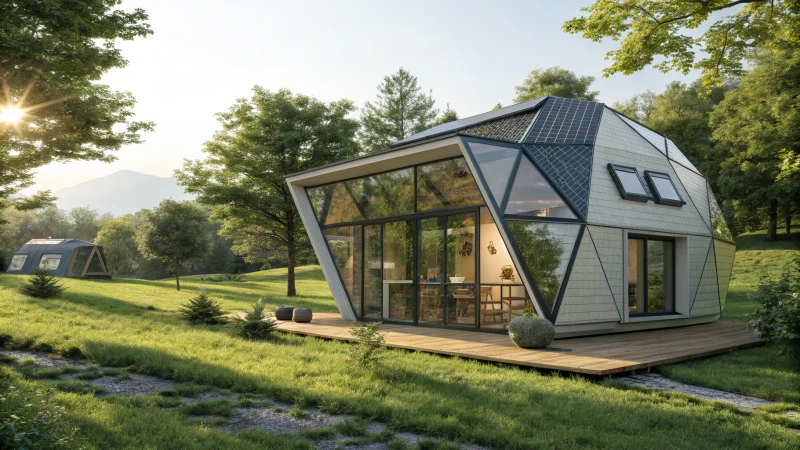
Modular Construction: Efficiency at Its Core
I remember walking through a busy construction site once—chaos and noise everywhere. Then I discovered modular construction. It's like building a house out of giant LEGO pieces. These components are manufactured in a controlled factory setting, which means less waste and faster build times. And did you know that China is a leader in this? They're crafting homes that can be swiftly set up even in the most remote places.
| Aspect | Benefits |
|---|---|
| Reduced Waste | Less material wastage on site |
| Speed of Construction | Shorter build times |
| Quality Control | Factory-controlled environments |
Advanced Materials & Smart Technology
I love the feeling of stepping into a home where everything just works perfectly. Capsule houses achieve this through materials like carbon fiber and insulated steel—materials so light and strong, they cut down transportation emissions and energy use significantly. The tech side is fascinating too! Imagine homes with solar panels and IoT systems that adjust to your needs, making life easier and greener.
- Carbon Fiber: Lightweight yet strong, reducing energy use by up to 40%
- Smart Tech: Features like solar panels can cut energy consumption by 60%
Energy-Efficient Design
Energy bills are everyone's nightmare, right? Capsule houses tackle this head-on. Picture built-in solar panels and rainwater systems working in harmony, lowering costs without you lifting a finger. These homes harness nature's own systems for heating and cooling, making them stand out as pioneers in sustainable housing9.
Customization for Diverse Needs
Now, customization is where these homes truly shine. From luxury tourism setups to emergency shelters, capsule houses can be tailored to meet almost any need. I once saw a luxurious glamping site completely transformed with these houses—it was like stepping into another world.
- Tourism: Tailored luxury finishes
- Emergency Housing: Quick deployment with essential features
Capsule houses embody the future of sustainable living—efficient, adaptable, and eco-friendly. If you're on a journey towards sustainable choices in housing, these homes offer innovative solutions that may just redefine how we live. Dive deeper into how capsule housing solutions10 might be the perfect fit for your needs.
Modular construction reduces building waste by 50%.True
Modular construction significantly cuts waste as components are pre-fabricated and assembled on-site.
Capsule houses can't be customized for luxury tourism.False
Capsule houses can be tailored with luxury finishes, making them suitable for tourism.
Conclusion
China's ultra-modern capsule houses utilize modular construction, advanced materials, and smart technologies to create sustainable, customizable homes that are efficient and rapidly deployable in various settings.
-
Explore how factory-controlled settings enhance quality control and consistency in modular construction. ↩
-
Discover how modular designs offer flexible customization to meet unique client requirements. ↩
-
Explore how eco-friendly materials contribute to sustainable housing solutions. ↩
-
Discover how carbon fiber reduces weight and enhances durability in construction. ↩
-
Explore how IoT systems enhance home automation and efficiency in capsule houses. ↩
-
Learn about the energy-saving benefits of solar panels in capsule homes. ↩
-
Discover why carbon fiber is advantageous for lightweight, durable construction. ↩
-
Understand how smart thermostats contribute to energy efficiency and cost savings. ↩
-
Discover the key design features that make capsule houses energy-efficient. ↩
-
Find out how capsule houses can be customized to meet diverse housing needs. ↩



